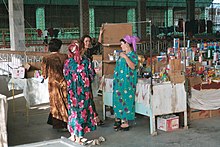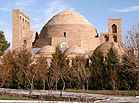Termez
Termez
Termiz / Термиз | |
|---|---|
| Coordinates: 37°13′N 67°17′E / 37.217°N 67.283°E | |
| Country | |
| Region | Surxondaryo Region |
| Established | 1929 |
| Government | |
| • Type | City Administration |
| Elevation | 302 m (991 ft) |
| Population (2014) | |
| • Total | 136,200 |
| Postal code | 190100 |
Termez (Uzbek: Termiz/Термиз; Russian: Термез; Tajik: Тирмиз; Persian: ترمذ Termez, Tirmiz; Arabic: ترمذ Tirmidh; Ancient Greek Tàrmita, Thàrmis, Θέρμις) is a city in the southernmost part of Uzbekistan near the Hairatan border crossing of Afghanistan. It is the hottest point of Uzbekistan. It has a population of 140,404 (1 January 2005), and is the capital of Surxondaryo Region.
Etymology
The modern name of the city came through the Sogdian Tarmiδ dating back to Old Iranian tara-maiθa , which means "a place of transition" (tara-crossing, crossing; maiθa-place). In ancient times there was an important crossing on the Amu Darya river.
Some link the name of the city to Greek thermos "hot", tracing its name back to Alexander the Great.[1] Others suggest that it came from Sanskrit taramato , meaning "on the river bank".[2]
History
In ancient times
The date of the founding of the city of Old Termez, located a few kilometers west of the modern city, is not known. In April 2002 there was a celebration of the 2,500th anniversary of the city of Termez. [2]
The city was known to Achaemenids in the 6th century BC. In 329 BC Alexander the Great conquered Termez. Later Demetrius, the founder of Greco-Bactrian kingdom named it Demetris. As part of the Kushan Empire (1st to 3rd century BC) The city was called Ta-li-mi (in the Chinese Tu-mi, Tami. During this period, the city became an important center of Buddhism.
In the 5th and 6th centuries the city was ruled by Hephthalites and Sassanids.
In the 7th century the city was ruled by the native Termez shah dynasty. It was a vassal of Gokturks.
In 705 the city was captured by the Arabs and it became one of the centres of Islam during the Abbadids and Samanids Empire, producing notable scholars like Imam Al-Tirmidhi.
From the 9th to the 12th centuries Termez was a big city and a cultural centre and was popular for shopping and crafts. At this time the length of the fortifications of the city was 16 kilometres (10 miles) long with nine gates. During this period Termez was a part of the Ghaznavids, Seljuk and Karakhanids. In 1206 the town became part of the state Khorezmshahs.
In 1220 after a two-day siege, the city was destroyed by the troops of Genghis Khan.
Ibn Battuta noted the city had "fine buildings and bazaars, traversed by canals, and with many gardens."[3]
In the second half of the 13th century Termez was restored to the east, on the right bank of Surxondaryo River, as part of the Timurid empire, then Shaybanids. By the second half of the 18th century the city was abandoned. The only inhabited villages were Salavat and Pattakesar (Pattagissar) in the vicinity of the ancient city.
In the Russian Empire and the Soviet Union
In January 1893 the emirate of Bukhara gave the land of the village Pattakesar to the Russian government to build a Russian fortress and garrison and a military border fortification, where the Amu Darya river port was built.
In 1928 as part of the Soviet Union, Pattakesar was renamed and took the city's ancient name Termez. In 1929, the village became a town.
During the years of Soviet rule industrial enterprises were built and a Pedagogical Institute and a theatre were opened.
During the Soviet–Afghan War (1979–1989), Termez was an important military base, a military airfield and a road-rail bridge across the Amu Darya ("Bridge of Friendship") were built.
Independent Uzbekistan
In 1992 the Pedagogical Institute was upgraded to Termez State University.
The military airfield in Termez is used by the air forces of Germany for transiting goods to Afghanistan.
In July 2009 It was decided to establish a "Termez regional railway junction" which will be one of the main places in the planned transit of non-lethal NATO supplies to Afghanistan. The transit will be through Russia, Kazakhstan and Uzbekistan bypassing Turkmenistan through the railway in 2009 Tashguzar-Boysun-Kumkurgan. [3]
In June 2015, the Prime Minister of Pakistan Nawaz Sharif announced the construction of the Gwadar-Termez Highway, which would connect Uzbekistan via a road network to the Arabian sea at Gwadar Port in Pakistan.[4]
Transportation
The river Amu Darya divides the two countries of Uzbekistan and Afghanistan and the Afghanistan–Uzbekistan Friendship Bridge crosses the river to Hairatan in Afghanistan. Termez is also served by Termez Airport, with flights to Tashkent and Moscow. Termez is connected with Uzbek Railways to other cities of the countries and Mazar-i-Sharif, Afghanistan. Tashkent-Termez (No: 379) and Termez-Tashkent (No: 380) train runs every day.[5] Also Dushanbe-Kanibadam (No: 367) and Kanibadam-Dushanbe (No: 368) trains passes from Termez.
Demographics
The officially registered population of Termez in 2005 was 140,404. Uzbeks and Tajiks are the largest ethnic groups.
Climate
Termez has a cold desert climate (BWk) with very hot, long summers and short, cool winters.
| Climate data for Termez (1981–2010, extremes 1936–present) | |||||||||||||
|---|---|---|---|---|---|---|---|---|---|---|---|---|---|
| Month | Jan | Feb | Mar | Apr | May | Jun | Jul | Aug | Sep | Oct | Nov | Dec | Year |
| Record high °C (°F) | 23.9 (75.0) |
30.1 (86.2) |
37.3 (99.1) |
38.7 (101.7) |
43.6 (110.5) |
46.5 (115.7) |
47.0 (116.6) |
46.3 (115.3) |
41.5 (106.7) |
37.5 (99.5) |
33.5 (92.3) |
26.7 (80.1) |
47.0 (116.6) |
| Mean daily maximum °C (°F) | 10.4 (50.7) |
13.2 (55.8) |
18.9 (66.0) |
26.6 (79.9) |
32.8 (91.0) |
38.0 (100.4) |
39.7 (103.5) |
38.0 (100.4) |
32.8 (91.0) |
25.8 (78.4) |
18.8 (65.8) |
12.1 (53.8) |
25.6 (78.1) |
| Daily mean °C (°F) | 4.2 (39.6) |
6.7 (44.1) |
12.1 (53.8) |
18.9 (66.0) |
24.6 (76.3) |
29.1 (84.4) |
30.5 (86.9) |
28.4 (83.1) |
22.9 (73.2) |
16.5 (61.7) |
10.8 (51.4) |
5.7 (42.3) |
17.5 (63.5) |
| Mean daily minimum °C (°F) | −0.3 (31.5) |
1.6 (34.9) |
6.5 (43.7) |
12.1 (53.8) |
16.5 (61.7) |
19.9 (67.8) |
21.5 (70.7) |
19.4 (66.9) |
14.1 (57.4) |
8.8 (47.8) |
4.8 (40.6) |
1.0 (33.8) |
10.5 (50.9) |
| Record low °C (°F) | −23.9 (−11.0) |
−21.7 (−7.1) |
−7.9 (17.8) |
−2.0 (28.4) |
−0.1 (31.8) |
11.4 (52.5) |
12.9 (55.2) |
9.3 (48.7) |
4.6 (40.3) |
−4.2 (24.4) |
−11.0 (12.2) |
−18.4 (−1.1) |
−21.7 (−7.1) |
| Average precipitation mm (inches) | 24.3 (0.96) |
23.7 (0.93) |
36.4 (1.43) |
23.5 (0.93) |
9.5 (0.37) |
1.5 (0.06) |
0.2 (0.01) |
0.0 (0.0) |
0.5 (0.02) |
3.2 (0.13) |
11.1 (0.44) |
20.5 (0.81) |
154.4 (6.09) |
| Average precipitation days | 10 | 11 | 11 | 8 | 5 | 1 | 1 | 0 | 1 | 3 | 6 | 9 | 66 |
| Average snowy days | 4 | 3 | 1 | 0.03 | 0.1 | 0 | 0 | 0 | 0.03 | 0.1 | 1 | 3 | 12 |
| Average relative humidity (%) | 77 | 71 | 66 | 57 | 45 | 36 | 36 | 38 | 45 | 53 | 65 | 76 | 55 |
| Mean monthly sunshine hours | 139.5 | 144.1 | 189.1 | 246.0 | 334.8 | 375.0 | 384.4 | 362.7 | 315.0 | 257.3 | 195.0 | 139.5 | 3,082.4 |
| Mean daily sunshine hours | 4.5 | 5.1 | 6.1 | 8.2 | 10.8 | 12.5 | 12.4 | 11.7 | 10.5 | 8.3 | 6.5 | 4.5 | 8.4 |
| Source 1: Centre of Hydrometeorological Service of Uzbekistan[6] | |||||||||||||
| Source 2: Pogoda.ru.net (mean temperatures/humidity/snow days 1981–2010, record low and record high temperatures),[7] Deutscher Wetterdienst (sun 1961–1990)[8] | |||||||||||||
Notable people of ancient Termez
- Its most famous native son is Al-Tirmidhi, born in its suburb Bugh and buried 60 kilometers north of Termez, on the outskirts of Sherobod, Uzbekistan. He is one of the six canonical hadith collectors of Sunni Islam. He is locally known as Abu Isa At Termezi.
- Hakim-at-Termizi, one of the famous Sufi theologians, is buried in old Termez which is in the suburbs of modern Termez. He is also known as Termez Ota (a patron saint of Termez).
- Sayyid Ali Akbar was an Islamic saint, the son of the eleventh Shia Imam, Hasan al-Askari and the brother of the twelfth Imam, Muhammad al-Mahdi. Sayyid Ali Akbar is Sultan Saadat (Sodot) who died in Termez. His burial place is located in the main mausoleum Sultan Saodat memorial complex in Termez.
- Adib Sabir Persian poet 12th-century.
- Said Baraka was from old Termez. He was a philosopher, war strategist and religious nobleman, and Amir Temur's teacher.
- Ali Termezi known as " Pir Baba " was a Tajik born in Termez, (1502–1583 CE), his mausoleum is in a village named Pir Baba after him in Buner District of Khyber Pakhtunkhwa, Pakistan.
- Valery Khalilov (1952–2016) was born in Termez. He was a Russian general and a composer.
Main historical sights

- Kyrk-Kyz Fortress (out-of-town Palace Country Estate) (9th–14th centuries)
- Palace of Termez rulers (11th–12th centuries)
- Architectural Complex of Al Hakim At-Termizi (10th–15th centuries)
- Architectural Ensemble Sultan Saodat (10th–18th centuries)
- Kokildora Khanaka (16th century)
- Kara Tepe Buddhist Monastery (2nd–4th centuries)
- Fayaz-Tepe Buddhist Monastery (1st–3rd centuries)
- Zurmala Tower (1st–2nd century AD)
- Abu Isa At-Tirmidhi Mausoleum (9th century AD), in the suburb of Sherobod, 60 kilometers north of Termez.
- Zul Kifl Mausoleum in the island Aral-Paygambar on the Amu Darya river. It is not possible to access it at the moment since it is in the military zone and the restricted nature reserve.
Wars

For many years after the Second World War the 108th Motor Rifle Division, the former 360th Rifle Division, was based in the town.
During the war in Afghanistan (1979–1989) over 100,000 Soviet troops were based in Termez. The airbase is currently the main support base for German and Dutch forces operating with the ISAF in Afghanistan.
See also
References
- ^ E. M. Pospelov, Geograficheskie nazvaniya mira (Moscow, 1998), p. 415: "here in fact is found the hottest place in Central Asia (in June 1914 a temperature of 49.5 C was recorded in Termez."
- ^ Sh. Kamaliddinov, Istoricheskaya geografiya Sogda i Toharistana.
- ^ Battutah, Ibn (2002). The Travels of Ibn Battutah. London: Picador. p. 143. ISBN 9780330418799.
- ^ Routes to Central Asia being constructed, says Nawaz Dawn News, Pakistan
- ^ http://www.advantour.com/uzbekistan/uzbekistan_railways.htm
- ^ "Average monthly data about air temperature and precipitation in 13 regional centers of the Republic of Uzbekistan over period from 1981 to 2010". Centre of Hydrometeorological Service of the Republic of Uzbekistan (Uzhydromet). Archived from the original on 15 December 2019. Retrieved 15 December 2019.
- ^ "Weather and Climate - The Climate of Termez" (in Russian). Weather and Climate (Погода и климат). Archived from the original on 6 December 2016. Retrieved 6 December 2016.
- ^ "Klimatafel von Termis (Termez) / Usbekistan" (PDF). Baseline climate means (1961–1990) from stations all over the world (in German). Deutscher Wetterdienst. Retrieved 9 June 2017.










